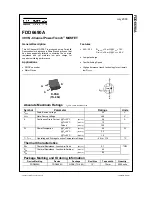
7-8
Optimizing DSP56300/DSP56600 Applications
MOTOROLA
Compact Opcode Use
Special Instructions
7.4
SPECIAL INSTRUCTIONS
7.4.1
Dual Data Spaces
The Harvard architecture of the DSP56300/DSP56600 cores includes
two data memory spaces: X and Y. An efficient structure of the
application’s data segment can improve the code performance by
being able to use instructions that support this architecture. For
example, the following code:
move
x:(r0),x0
move
x:(r4),y0
In this code, two data arrays were put into the same memory space,
while the code had to access an item from each array one after the
other. Instead, if one of the arrays can be put into the other data
memory space (Y in this example) then the two items can be
accessed on the same instruction:
move
x:(r0),x0 y:(r4),y0
7.4.2
Using the TFR instructions
The TFR instruction is unique by giving the ability to combine two
move operations into a single instruction in a way that is not
supported by the usual parallel opcodes. Example:
move
x0,a
move
r1,r2
This example can be optimized by combining the two move
instructions into a single TFR instruction:
tfr
x0,a
r1,r2
















































